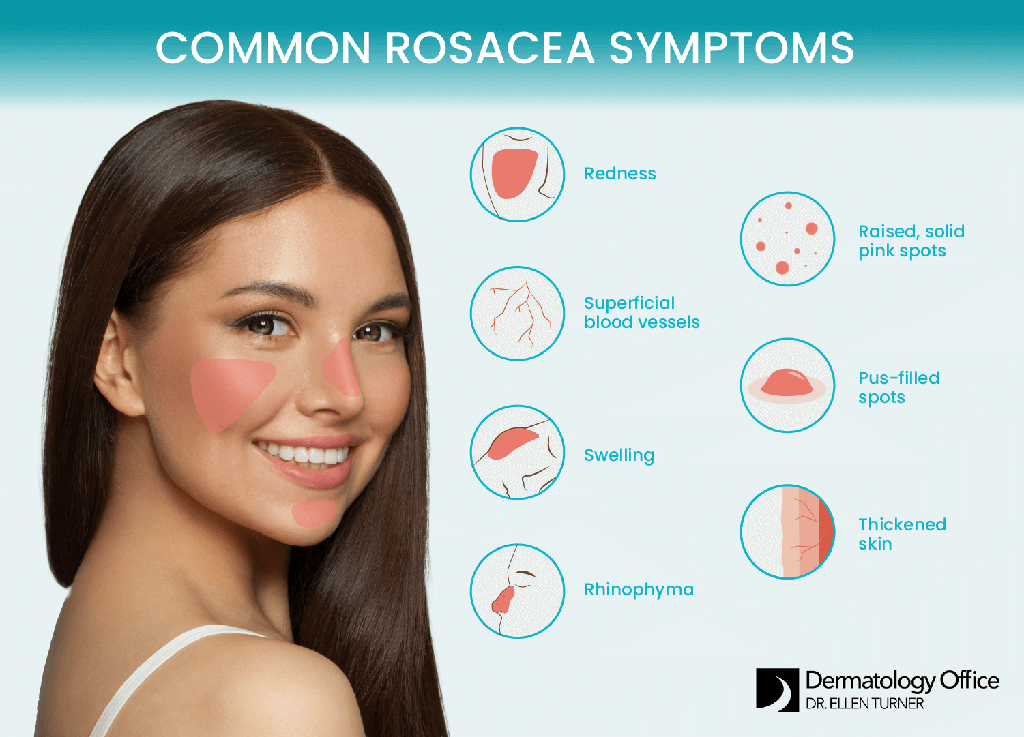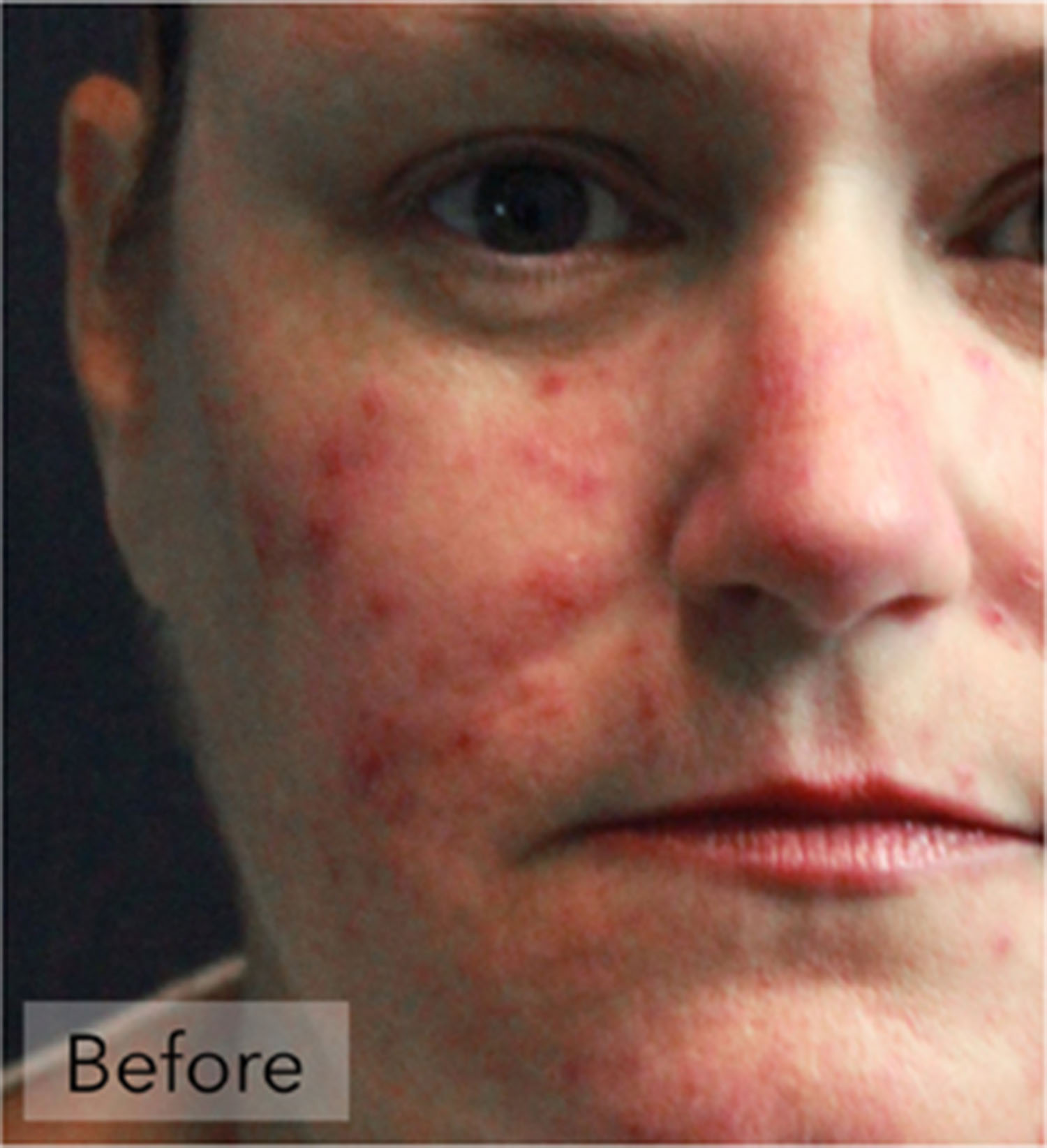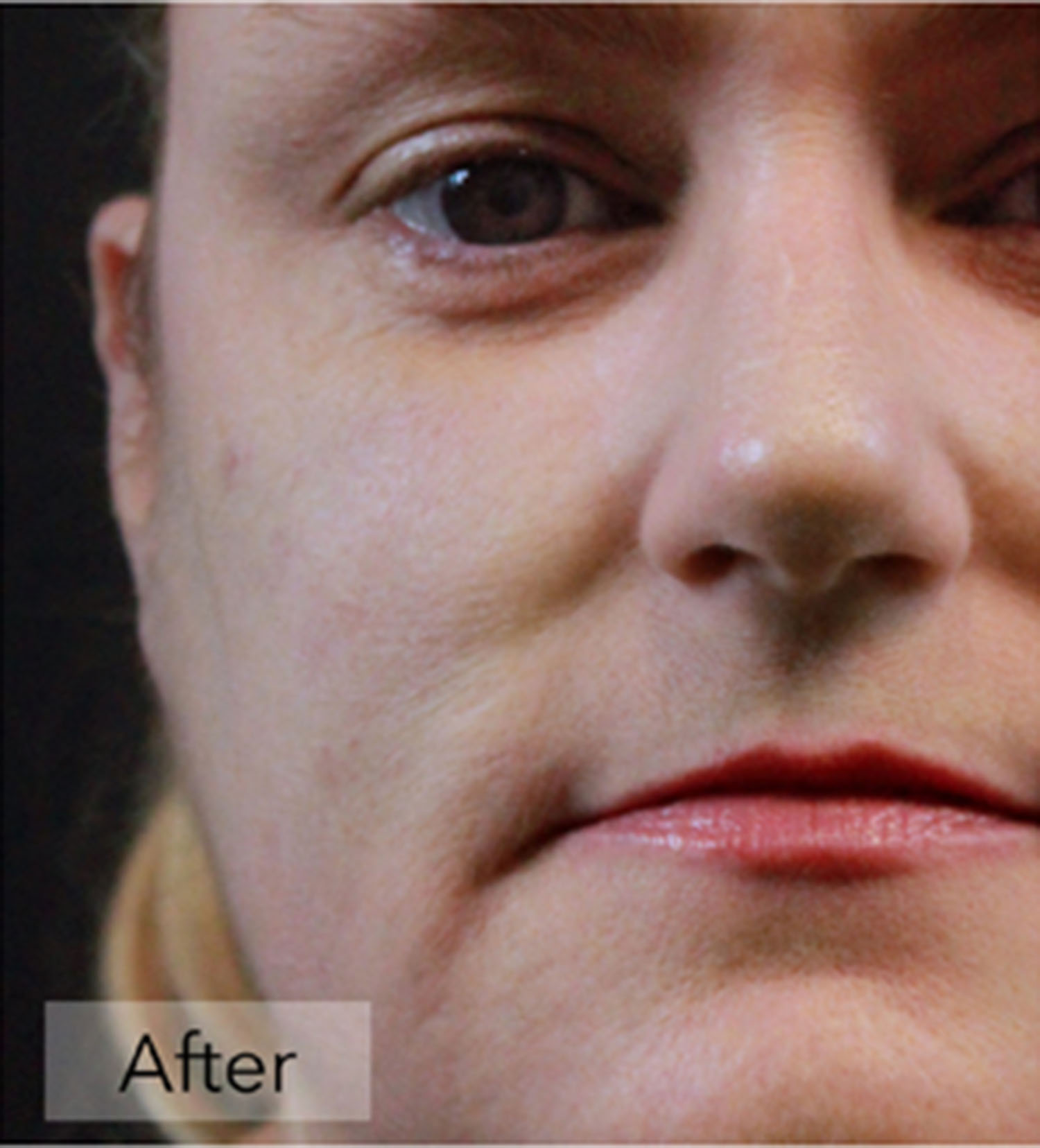Medical Dermatology
Rosacea
- Home
- General Dermatology
- Rosacea
Get Diagnosis and Help with Chronic Redness in Dallas
 Rosacea is a common skin disease that frequently begins as a tendency to flush or blush easily. As rosacea progresses, people often develop persistent redness in the center of the face. This redness may gradually spread beyond the nose and cheeks to the forehead and chin. Dr. Ellen Turner has significant experience in diagnosing and working with patients who have rosacea in the Dallas area.
Rosacea is a common skin disease that frequently begins as a tendency to flush or blush easily. As rosacea progresses, people often develop persistent redness in the center of the face. This redness may gradually spread beyond the nose and cheeks to the forehead and chin. Dr. Ellen Turner has significant experience in diagnosing and working with patients who have rosacea in the Dallas area.
Tiny blood vessels, which many call spider veins, can develop. Some people see small red bumps that usually appear in crops. Some of the red bumps may contain pus. Dermatologists call the pus-filled bumps “pustules.” If the bumps do not contain pus, they are called “papules.” These pustules and papules resemble acne, so people often refer to the symptoms as “adult acne.” Unlike acne, however, blackheads do not develop.
Medical Dermatology
Book an appointment online or call (214) 373-7546 to schedule an appointment to see us for rosacea in our Dallas or Irving locations.
Rosacea can also cause the affected skin to swell, as well as affect the eyes. About 50 percent of patients with this chronic condition have eye involvement, also called “ocular rosacea.” This often causes dryness, burning, and grittiness, and can lead to serious eye complications.
What are the Signs of Rosacea, and Who is at Risk?

Patients who bring their rosacea to Dallas and Irving’s Dermatology Office are often dealing with some combination of symptoms that may include general redness (especially on the cheeks), raised spots with a solid pink color or filled with pus, spider veins or other visible blood vessels, facial swelling, and thickened skin (especially on the nose).
Early rosacea can be difficult to recognize. When the condition first develops, the redness tends to come and go. Many people may consider this nothing more than flushing that lasts longer than normal. The visible blood vessels can be seen as an inevitable sign of aging. If papules and pustules appear, these can be mistaken for adult acne.
When the skin does not return to its normal color and when other signs—such as pimples and visible blood vessels—appear, it is best to see a licensed dermatologist, such as Dr. Ellen Turner. Left untreated, rosacea can worsen and become more difficult to manage. Self-diagnosis and at-home treatment are not recommended. Some over-the-counter treatments can worsen rosacea.
There are risk factors that may make someone more likely to develop this condition than others. It’s more likely to occur between the ages of 30 and 50. People who are blond, blue eyed, and fair-skinned have a higher risk for this chronic skin disease. It is more common in women than men, but it’s more likely for men to have severe forms of the condition. Genetic factors may also have an influence, as it may often develop in several family members.
Although fair-skinned adults between the ages of 30 and 50 may be at greater risk, people of all races, ethnic groups, and ages can develop rosacea. It affects men and women of any demographic—and even children.
Since rosacea can be associated with menopause, women are affected more often than men. As women approach menopause, they may notice an extreme sensitivity to cosmetics and skin-care products. These can be symptoms of rosacea. Both men and women may notice that a particularly embarrassing or tense moment triggers flushing that lasts longer than in other people.
If you experience any of these symptoms, it is important to see a licensed dermatologist. Rosacea tends to be a chronic (last for years) and progressive condition that rarely reverses itself.
Common Types of Rosacea in the Dallas Area
To find the most appropriate treatment plan, we have to first determine which type or types of rosacea are present in a patient. There are four main types of the disease. Sometimes patients may have more than one type, and the symptoms may overlap and occur at the same time.
Subtype One (Facial)
This type of rosacea, which is also called erythematotelangiectatic rosacea (ETR) is characterized by symptoms such as facial discoloration in the form of redness at the center of the face, flushing, and tiny, visible blood vessels in spider vein patterns. This skin type tends to be prone to burning, stinging, flushing, and swelling. It’s also likely to become rough, dry, and scaly. This is the most common and well-known form of the condition.
Subtype Two (Acne-Like)
Rosacea subtype two, also known as papulopustular or “acne rosacea,” is associated with flushing, swelling, and breakouts of very large, painful bumps on the face that looks similar to acne. These bumps develop deep in the skin and may be filled with pus. Most of the time, these papules and pustules will occur in the center of the face, but they may occasionally develop on the scalp and neck, or even the shoulders and chest in severe cases. Other symptoms of acne-like rosacea include oiliness, sensitivity, stinging, burning, spider veins, and raised, hardened blemishes called plaques. This subtype mostly occurs in middle aged women.
Subtype Three (Thickening Skin)
Phymatous rosacea or rhinophyma is a rarer type of condition that mostly occurs in men. It causes thickening of the skin and bumpiness on the nose, forehead, cheeks, chin, and ears. Most of the time, this subtype will affect the nose. Patients who have this will usually also have another type of rosacea that occurred first.
Subtype Four (Eyes)
Subtype four, ocular rosacea, has symptoms that affect the eye area. The redness and inflammation from this form of rosacea impact the insides of the eyes, the eyelids, and the skin surrounding the eyes. When you have this subtype, your eyes may be watery, bloodshot, and feel like they have sand in them. In addition to the eye redness and irritation, there are often other symptoms such as swelling of the eyelids, broken blood vessels or cysts on the eyelids, blurry or weak vision, oversensitivity to light, and dryness, stinging, burning, and itching in the eye areas.
Medical Dermatology
Request an appointment online or call (214) 373-7546 to see us about rosacea in our Dallas or Irving locations.
Rosacea Treatment and Tips
To effectively manage rosacea, Dr. Ellen Turner usually recommends a combination of treatments tailored to the individual patient. This approach can stop the condition from progressing and may sometimes halt it.
Many treatments are applied directly to the affected skin. Creams, lotions, foams, washes, gels, and pads that contain a topical antibiotic, azelaic acid, metronidazole, sulfacetamide, benzoyl peroxide, or retinoids may be prescribed. A newer prescription medication containing brimonidine can actually reduce the flushing that can occur. While these topical treatments are effective, improvement can take time. A slight improvement may be seen in the first three to four weeks. Greater improvement usually takes about two months.
Faster results may be seen with oral antibiotics, especially to treat papules and pustules. Persistent redness may be treated with a small electric needle (electrodessication) or light treatments such as IPL (intense pulsed light) or BBL (broadband light). Laser treatments can also reduce the background skin redness as well as the papules and pustules. Cosmetics also may be helpful. Green-tinted makeup can mask the redness.
Light and Laser Therapy
In light and laser-based procedures like IPL and BBL, the devices give off a powerful, highly focused beam of light. The heat from these procedures collapses blood vessels that are visible through the surface of the skin so that they can no longer be seen. The light also reduces scars, removes redness, and reduces thickened skin from rhinophyma.
Laser treatments are usually used when other options haven’t been effective. After this treatment, the skin may remain shiny, irritated, and more sensitive for several days while the skin heals, and you should avoid sun exposure.
Electrodessication
In this quick, simple in-office treatment for rosacea, a high-frequency electric current from a pen-like device is used to heat the targeted area. The unwanted blood vessels clot and shrink. Scabs form on the treatment area. The skin heals quickly, and the scabs will resolve on their own after a few days have passed. This treatment is highly effective for removing larger blood vessels that are visible through the skin’s surface.
How Can You Control Symptoms of Rosacea?
Many everyday things can cause rosacea to flare. Anything that causes a flare-up is called a “trigger.” To help patients decrease flare-ups, dermatologists often recommend the following:
-
- Practice good sun protection. Sun exposure seems to be the most common trigger. Seek shade when possible, limit exposure to sunlight, wear protective clothing, and use non-irritating broad-spectrum (offers protection from UVA and UVB rays) sunscreen with SPF of 30 or higher. Reapply sunscreen every two hours. Physical block sunscreens with SPF 30 or higher that contain zinc oxide or titanium dioxide as the active ingredients are recommended as opposed to chemical blockers, which may aggravate the condition.
- Avoid certain foods and drinks. Spicy foods, hot drinks, caffeine, and alcoholic beverages are common rosacea triggers. Although alcohol can worsen it, the condition can be just as severe in someone who does not drink alcohol. Rosacea has been unfairly linked to alcoholism.
- Protect your skin from extreme hot and cold temperatures. These can exacerbate the condition. Exercise in a cool environment. Do not overheat. Protect your face from cold and wind with a non-irritating scarf or ski mask.
- Avoid rubbing, scrubbing, or massaging the face.
- Avoid cosmetics and skin care products that contain alcohol or other irritating substances. Use hair sprays properly, avoiding contact with facial skin.
- Keep your skin care routine simple. Fewer products are better.
- Note flushing episodes. While there are many known common triggers, what causes a flare in one person may not trigger it in another. By writing down what foods, products, activities, medications, and other factors cause your skin to flare, you will learn your triggers.
Outstanding patient care is a point of pride for Dr. Turner, and she aims to listen to unique concerns and choose the appropriate therapies for each individual. Consultations have a comfortable, informative, and respectful tone. To schedule a consultation with Dr. Turner to discuss rosacea in the Dallas or Irving areas, book an appointment or call the office at (214) 373-7546.
How Much Does Rosacea Treatment Cost?
Cost for rosacea treatment or any general dermatology issue will vary based on the type and extent of treatment recommended by Dr. Turner.



